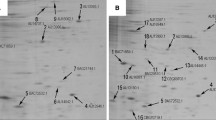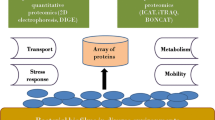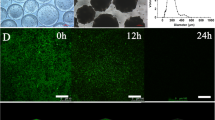Abstract
Metallic copper surfaces have strong antimicrobial properties and kill bacteria, such as Escherichia coli, within minutes in a process called contact killing. These bacteria are exposed to acute copper stress under dry conditions which is different from chronic copper stress in growing liquid cultures. Currently, the physiological changes of E. coli during the acute contact killing process are largely unknown. Here, a label-free, quantitative proteomic approach was employed to identify the differential proteome profiles of E. coli cells after sub-lethal and lethal exposure to dry metallic copper. Of the 509 proteins identified, 110 proteins were differentially expressed after sub-lethal exposure, whereas 136 proteins had significant differences in their abundance levels after lethal exposure to copper compared to unexposed cells. A total of 210 proteins were identified only in copper-responsive proteomes. Copper surface stress coincided with increased abundance of proteins involved in secondary metabolite biosynthesis, transport and catabolism, including efflux proteins and multidrug resistance proteins. Proteins involved in translation, ribosomal structure and biogenesis functions were down-regulated after contact to metallic copper. The set of changes invoked by copper surface-exposure was diverse without a clear connection to copper ion stress but was different from that caused by exposure to stainless steel. Oxidative posttranslational modifications of proteins were observed in cells exposed to copper but also from stainless steel surfaces. However, proteins from copper stressed cells exhibited a higher degree of oxidative proline and threonine modifications.



Similar content being viewed by others
References
Bagwell CE, Hixson KK, Milliken CE, Lopez-Ferrer D, Weitz KK (2010) Proteomic and physiological responses of Kineococcus radiotolerans to copper. PLoS One 5:e12427
Casey AL, Adams D, Karpanen TJ, Lambert PA, Cookson BD, Nightingale P, Miruszenko L, Shillam R, Christian P, Elliott TSJ (2010) Role of copper in reducing hospital environment contamination. J Hosp Infect 74:72–77
Chillappagari S, Seubert A, Trip H, Kuipers OP, Marahiel MA, Miethke M (2010) Copper stress affects iron homeostasis by destabilizing iron-sulfur cluster formation in Bacillus subtilis. J Bacteriol 192:2512–2524
Dukan S, Nystrom T (1998) Bacterial senescence: stasis results in increased and differential oxidation of cytoplasmic proteins leading to developmental induction of the heat shock regulon. Genes Dev 12:3431–3441
Dukan S, Nystrom T (1999) Oxidative stress defense and deterioration of growth-arrested Escherichia coli cells. J Biol Chem 274:26027–26032
Elguindi J, Wagner J, Rensing C (2009) Genes involved in copper resistance influence survival of Pseudomonas aeruginosa on copper surfaces. J Appl Microbiol 106:1448–1455
Elguindi J, Moffitt S, Hasman H, Andrade C, Raghavan S, Rensing C (2011) Metallic copper corrosion rates, moisture content, and growth medium influence survival of copper ion-resistant bacteria. Appl Microbiol Biotechnol. doi:10.1007/s00253-010-2980-x
Espirito Santo C, Taudte N, Nies DH, Grass G (2008) Contribution of copper ion resistance to survival of Escherichia coli on metallic copper surfaces. Appl Environ Microbiol 74:977–986
Espirito Santo C, Lam EW, Elowsky CG, Quaranta D, Domaille DW, Chang CJ, Grass G (2011) Bacterial killing by dry metallic copper surfaces. Appl Environ Microbiol 77:794–802
Fraser KR, Tuite NL, Bhagwat A, O’Byrne CP (2006) Global effects of homocysteine on transcription in Escherichia coli: induction of the gene for the major cold-shock protein, CspA. Microbiology 152:2221–2231
Gardy JL, Laird MR, Chen F, Rey S, Walsh CJ, Ester M, Brinkman FS (2005) PSORTb v.2.0: expanded prediction of bacterial protein subcellular localization and insights gained from comparative proteome analysis. Bioinformatics 21:617–623
Grass G, Rensing C, Solioz M (2011) Metallic copper as an antimicrobial surface. Appl Environ Microbiol 77:1541–1547
Helbig K, Bleuel C, Krauss GJ, Nies DH (2008) Glutathione and transition-metal homeostasis in Escherichia coli. J Bacteriol 190:5431–5438
Hubscher U, Kornberg A (1979) The delta subunit of Escherichia coli DNA polymerase III holoenzyme is the dnaX gene product. Proc Natl Acad Sci USA 76:6284–6288
Isarankura-Na-Ayudhya P, Isarankura-Na-Ayudhya C, Treeratanapaiboon L, Kasikun K, K T, Prachayasittikul V (2009) Proteomic profiling of Escherichia coli in response to heavy metals stress. Eur J Sci Res 25:679–688
Kao WC, Chen YR, Yi EC, Lee H, Tian Q, Wu KM, Tsai SF, Yu SS, Chen YJ, Aebersold R, Chan SI (2004) Quantitative proteomic analysis of metabolic regulation by copper ions in Methylococcus capsulatus (Bath). J Biol Chem 279:51554–51560
Kershaw CJ, Brown NL, Constantinidou C, Patel MD, Hobman JL (2005) The expression profile of Escherichia coli K-12 in response to minimal, optimal and excess copper concentrations. Microbiology 151:1187–1198
Levine RL, Stadtman ER (2001) Oxidative modification of proteins during aging. Exp Gerontol 36:1495–1502
Liu H, Sadygov RG, Yates JR III (2004) A model for random sampling and estimation of relative protein abundance in shotgun proteomics. Anal Chem 76:4193–4201
Macomber L, Imlay JA (2009) The iron-sulfur clusters of dehydratases are primary intracellular targets of copper toxicity. Proc Natl Acad Sci USA 106:8344–8349
Macomber L, Rensing C, Imlay JA (2007) Intracellular copper does not catalyze the formation of oxidative DNA damage in Escherichia coli. J Bacteriol 189:1616–1626
Magnani D, Barre O, Gerber SD, Solioz M (2008) Characterization of the CopR regulon of Lactococcus lactis IL1403. J Bacteriol 190:536–545
Mehtar S, Wiid I, Todorov SD (2007) The antimicrobial activity of copper and copper alloys against nosocomial pathogens and Mycobacterium tuberculosis isolated from healthcare facilities in the Western Cape: an in vitro study. J Hosp Infect 68:45–51
Mikolay A, Huggett S, Tikana L, Grass G, Braun J, Nies DH (2010) Survival of bacteria on metallic copper surfaces in a hospital trial. Appl Microbiol Biotechnol 87:1875–1879
Miller CD, Pettee B, Zhang C, Pabst M, McLean JE, Anderson AJ (2009) Copper and cadmium: responses in Pseudomonas putida KT2440. Lett Appl Microbiol 49:775–783
Molteni C, Abicht HK, Solioz M (2010) Killing of bacteria by copper surfaces involves dissolved copper. Appl Environ Microbiol 76:4099–4101
Monchy S, Benotmane MA, Wattiez R, van Aelst S, Auquier V, Borremans B, Mergeay M, Taghavi S, van der Lelie D, Vallaeys T (2006) Transcriptomic and proteomic analyses of the pMOL30-encoded copper resistance in Cupriavidus metallidurans strain CH34. Microbiology 152:1765–1776
Nägele E, Vollmer M, Horth P (2003) Two-dimensional nano-liquid chromatography-mass spectrometry system for applications in proteomics. J Chromatogr A 1009:197–205
Nandakumar R, Madayiputhiya N, Fouad AF (2009) Proteomic analysis of endodontic infections by liquid chromatography-tandem mass spectrometry. Oral Microbiol Immunol 24:347–352
Noyce JO, Michels H, Keevil CW (2006) Potential use of copper surfaces to reduce survival of epidemic meticillin-resistant Staphylococcus aureus in the healthcare environment. J Hosp Infect 63:289–297
Outinen PA, Sood SK, Liaw PC, Sarge KD, Maeda N, Hirsh J, Ribau J, Podor TJ, Weitz JI, Austin RC (1998) Characterization of the stress-inducing effects of homocysteine. Biochem J 332(Pt 1):213–221
Quaranta D, Krans T, Espirito Santo C, Elowsky CG, Domaille DW, Chang CJ, Grass G (2011) Mechanisms of yeast contact-killing on dry metallic copper surfaces. Appl Environ Microbiol 77:416–426
Requena JR, Chao CC, Levine RL, Stadtman ER (2001) Glutamic and aminoadipic semialdehydes are the main carbonyl products of metal-catalyzed oxidation of proteins. Proc Natl Acad Sci USA 98:69–74
Roberts SA, Weichsel A, Grass G, Thakali K, Hazzard JT, Tollin G, Rensing C, Montfort WR (2002) Crystal structure and electron transfer kinetics of CueO, a multicopper oxidase required for copper homeostasis in Escherichia coli. Proc Natl Acad Sci USA 99:2766–2771
Sharma S, Sundaram CS, Luthra PM, Singh Y, Sirdeshmukh R, Gade WN (2006) Role of proteins in resistance mechanism of Pseudomonas fluorescens against heavy metal induced stress with proteomics approach. J Biotechnol 126:374–382
Starkebaum G, Harlan JM (1986) Endothelial cell injury due to copper-catalyzed hydrogen peroxide generation from homocysteine. J Clin Invest 77:1370–1376
Tamarit J, Cabiscol E, Ros J (1998) Identification of the major oxidatively damaged proteins in Escherichia coli cells exposed to oxidative stress. J Biol Chem 273:3027–3032
Tatusov RL, Galperin MY, Natale DA, Koonin EV (2000) The COG database: a tool for genome-scale analysis of protein functions and evolution. Nucleic Acids Res 28:33–36
Teitzel GM, Geddie A, De Long SK, Kirisits MJ, Whiteley M, Parsek MR (2006) Survival and growth in the presence of elevated copper: transcriptional profiling of copper-stressed Pseudomonas aeruginosa. J Bacteriol 188:7242–7256
Warnes SL, Green SM, Michels HT, Keevil CW (2010) Biocidal efficacy of copper alloys against pathogenic enterococci involves degradation of genomic and plasmid DNAs. Appl Environ Microbiol 76:5390–5401
Weaver L, Michels HT, Keevil CW (2010) Potential for preventing spread of fungi in air-conditioning systems constructed using copper instead of aluminium. Lett Appl Microbiol 50:18–23
Yamamoto K, Hirao K, Oshima T, Aiba H, Utsumi R, Ishihama A (2005) Functional characterization in vitro of all two-component signal transduction systems from Escherichia coli. J Biol Chem 280:1448–1456
Acknowledgments
The mass spectrometry analysis was conducted at the Proteomic and Metabolomic Core facility, Redox biology center, UNL and the research was supported by NIH Grant Number P20 RR-17675, from the National Center for Research Resources. The contents of this article are solely the responsibility of the authors and do not represent the official views of the NIH. We also acknowledge funds from the International Copper Association (ICA), the Copper Development Association (CDA), and a University of Nebraska-Lincoln Office of Research Faculty Seed grant to G.G. C.E.S. was supported by a Fundação para a Ciência e Tecnologia, Portugal, graduate fellowship.
Author information
Authors and Affiliations
Corresponding author
Electronic supplementary material
Below is the link to the electronic supplementary material.
Rights and permissions
About this article
Cite this article
Nandakumar, R., Espirito Santo, C., Madayiputhiya, N. et al. Quantitative proteomic profiling of the Escherichia coli response to metallic copper surfaces. Biometals 24, 429–444 (2011). https://doi.org/10.1007/s10534-011-9434-5
Received:
Accepted:
Published:
Issue Date:
DOI: https://doi.org/10.1007/s10534-011-9434-5




